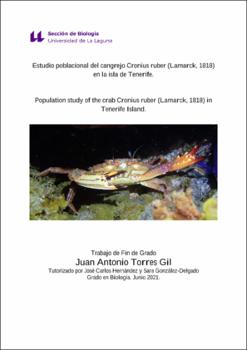Estudio poblacional del cangrejo Cronius ruber (Lamarck,1818) en la isla de Tenerife.
Autor
Torres Gil, Juan AntonioFecha
2021Resumen
Cronius ruber es una especie de crustáceo que pertenece a la familia de los Portúnidos y de
reciente aparición en las islas Canarias. Actualmente, este cangrejo es considerado como una posible
especie invasora, dada la rápida expansión de sus poblaciones y su capacidad de depredación sobre otros
organismos de los fondos rocosos someros de las islas. Sin embargo, son muy escasos los estudios que
han abordado el tema. Es por ello que el objetivo de este trabajo fue registrar su abundancia en distintas
localidades de la isla de Tenerife, estudiar su morfometría, determinar el estado de madurez sexual de
machos y hembras y la dureza de su caparazón. Los resultados revelan que la mayor densidad de C.
ruber registrada fue en Boca Cangrejo y Teno, predominando los machos en la mayoría de las localidades. El mayor tamaño de C. ruber se registró en Boca Cangrejo y Armeñime. Asimismo, se confirma
un dimorfismo sexual relacionado con la anchura de caparazón y longitud de la pinza derecha, siendo
los machos los que presentan un mayor tamaño de estas estructuras. C. ruber es fértil durante la mayor
parte del año y el caparazón es duro en la mayoría de los casos. Todas estas son características que
confirman su capacidad invasora en Canarias, donde se prevé un aumento drástico de su población debido a los ambientes favorables que encuentra en las islas. Cronius ruber is a crustacean species that belongs to the Portunid family that has recently appeared in the Canary Islands. Currently, this crab is considered a possible alien species, due to the fast
expansion of its populations and its predatory ability against other organisms of the rocky reefs in these
islands. Nevertheless, the studies treating this subject are scarce. For that reason, the aim of this research
was to record its abundance in different Tenerife locations, to carry out a morphometric study, to determine the states of sexual maturity of male and female crabs and the hardness of its carapace. The results
reveal that the highest density of C. ruber recorded was in Boca Cangrejo and Teno, with males predominating in most locations. The greater size of C. ruber was registered in Boca Cangrejo and
Armeñime. In addition, a sexual dimorphism related to the width of the carapace and length of the right
claw is confirmed, with males showing a larger size of these structures. C. ruber is fertile most of the
year and its carapace is hard most of the cases. All these are characteristic that confirm its invasive
capacity in the Canary Islands, where a drastic increase of its population is foreseen due to the favorable
environments found in the islands.





